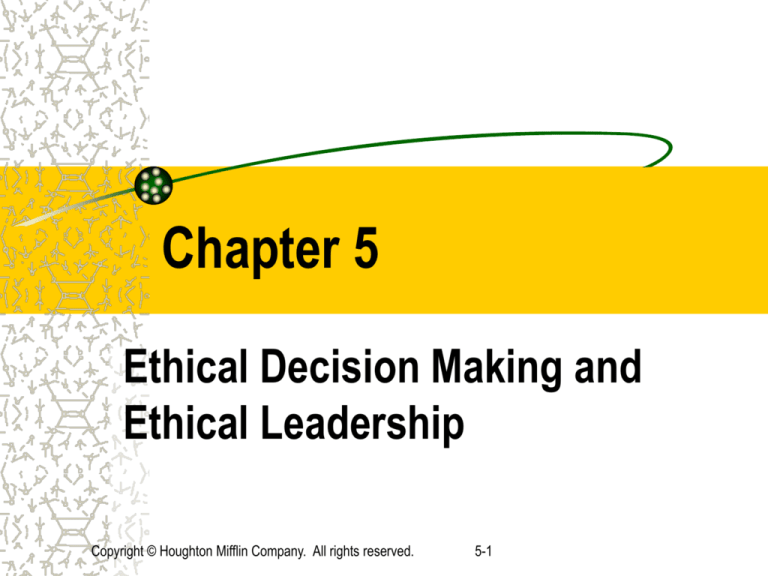
Chapter 5
Ethical Decision Making and
Ethical Leadership
Copyright © Houghton Mifflin Company. All rights reserved.
5-1
Understanding the Ethical
Decision-Making Process
The first step in ethical-decision
making is to recognize that an ethical
issue requires an individual or work
group to choose among several
actions that various stakeholders
inside or outside the firm will ultimately
evaluate as right or wrong.
Copyright © Houghton Mifflin Company. All rights reserved.
5-2
Framework for Understanding
Ethical Decision-Making in Business
Copyright © Houghton Mifflin Company. All rights reserved.
5-3
Ethical Issue Intensity
Ethical issue intensity is the perceived relevance or
importance of an ethical issue in the eyes of the
individual, work group, and/or organization.
– Reflects the ethical sensitivity of the individual or
work group and triggers the ethical decision process
Positive or negative incentives can affect the perceived
importance of an ethical issue.
Employees need education regarding potential
problem areas.
Copyright © Houghton Mifflin Company. All rights reserved.
5-4
Individual Factors
How people resolve ethical issues in their daily
lives is often based on values and principles
learned through family socialization.
In the workplace, ethical issues involve honesty,
conflicts of interest, discrimination, nepotism
(favoritism), and theft.
The individual’s stage of cognitive development
can affect conduct.
Copyright © Houghton Mifflin Company. All rights reserved.
5-5
Individual Factors
Individual factors include:
–
–
–
–
–
–
Gender
Education
Work experience
Nationality
Age
Locus of control
Copyright © Houghton Mifflin Company. All rights reserved.
5-6
Organizational Factors
Corporate culture: a set of values, beliefs, goals,
norms and ways to solve problems that
members (employees) of an organization share
– Some corporate cultures support and reward
unethical behavior.
– Ethical climate is a component of corporate culture.
Copyright © Houghton Mifflin Company. All rights reserved.
5-7
Ethical Climate
The character or decision processes used to determine
whether actions are ethical or unethical
Consists of corporate codes of ethics, top management
actions, ethical policies, coworker influence, and the
opportunity for unethical behavior
The perceived ethics of the immediate work group has
been found to be a major factor influencing ethical
behavior.
Copyright © Houghton Mifflin Company. All rights reserved.
5-8
Significant Others
The work group, which includes people such as
peers, managers, and subordinates
Help on a daily basis with unfamiliar tasks and
provide advice and
information formally
and informally
Have more influence
on daily decisions
than any other factor
Copyright © Houghton Mifflin Company. All rights reserved.
5-9
Obedience to Authority
An aspect of influence that significant others can
exercise
Helps us explain why many employees resolve
business issues by simply following the
directives of a superior
Copyright © Houghton Mifflin Company. All rights reserved.
5-10
Opportunity
Relates to permitting ethical or unethical
behavior
Results from rewards and punishment and it
plays a key role
Relates to the employee’s immediate job
context ,where they work? Whom they work with? Nature
of work?
Unethical behavior can be eliminated by
establishing formal codes, policies, and rules
that are enforced
Copyright © Houghton Mifflin Company. All rights reserved.
5-11
Business Ethics Evaluations
and Intentions
Ethical dilemmas involve problem-solving situations in which
decision rules are often vague or in conflict.
Critical thinking plays a key role for solving problems.
A person’s intentions along with the final decision on what
action to take is the last step in the ethical decision-making
process.
If intentions and behavior are not consistent with ethical
judgments, the individual may feel guilt.
Most businesspeople will make ethical mistakes.
Copyright © Houghton Mifflin Company. All rights reserved.
5-12
The Role of Leadership in
Corporate Culture
Leadership is the ability or authority
to guide and direct others toward
achievement of a goal.
Leaders are key to influencing an
organization’s corporate culture and
ethical posture.
Leadership styles influence many
aspects of organizational behavior,
including employees’ acceptance of
and adherence to organizational
norms and values.
Copyright © Houghton Mifflin Company. All rights reserved.
5-13
The Role of Leadership in
Developing an Ethics Plan
Copyright © Houghton Mifflin Company. All rights reserved.
5-14
Leadership Styles
Coercive leaders: demand obedient and focus on
achievement
Authoritative leaders: The most effective styles.
Affiliative leaders : Relies on friendship
Democratic leaders: Relies on participation
Pacesetting leaders: relies on standards and rules
,procedures
Coaching leaders: Developing skills, delegate
responsibilities.
Copyright © Houghton Mifflin Company. All rights reserved.
5-15
Leadership
The most successful leaders do not rely on one
style of leadership but alternate their technique
based on the characteristics of the situation.
Copyright © Houghton Mifflin Company. All rights reserved.
5-16
Types of Leaders
Transactional leaders attempt to create employee
satisfaction through negotiation, or bartering for desired
behaviors or levels of performance.
Transformational leaders strive to raise employees’ level of
commitment and to foster trust and motivation.
Transformational ethical leadership is best suited for
organizations that have higher levels of ethical
commitment among employees and strong stakeholder
support for an ethical culture.
Copyright © Houghton Mifflin Company. All rights reserved.
5-17
Habits of Strong Ethical Leaders
1.
2.
3.
4.
5.
6.
7.
Ethical leaders have a strong personal character.
Ethical leaders have a passion to do right.
Ethical leaders are proactive.
Ethical leaders consider stakeholders’ interests.
Ethical leaders are role models for the organization’s
values.
Ethical leaders are transparent and actively involved
in organizational decision-making.
Ethical leaders are competent managers who take a
holistic view of the firm’s ethical culture.
Copyright © Houghton Mifflin Company. All rights reserved.
5-18




